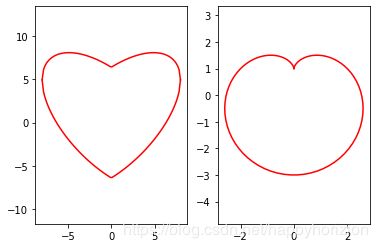tensorflow 2.0系列(3):eager execution和计算图
目录
- tf 2.0 的新特性:eager execution
- 开启eager模式
- 关闭eager模式
- 构建图
- 默认图
- 创建多个计算图
- 启动会话
- 从公式到计算图
- 绘制心形曲线
- 开根号
- 线性回归
tf 2.0 的新特性:eager execution
tensorflow经典的方式是需要构建计算图,启动会话后,张量在图中流动进行计算。在tf 2.0最大的特色之一就在于eager execution,大大简化了之前这个繁琐的定义和计算过程。
eager execution提供了一种命令式的编程环境,简单地说就是不需要构建图,直接可以运行。在老版本中,需要先构建计算图,然后再执行。在r1.14之后,tensorflow引入了eager execution,为快速搭建和测试算法模型提供了便利。
开启eager模式
tf 2.0 中,默认情况下,Eager Execution 处于启用状态。可以用tf.executing_eargerly()查看Eager Execution当前的启动状态,返回True则是开启,False是关闭。可以用tf.compat.v1.enable_eager_execution()启动eager模式。
import tensorflow.compat.v1 as tf
tf.enable_eager_execution()
print('eager execution ? '+ str(tf.executing_eagerly())) # => True
x = [[1.]]
m = tf.add(x, x)
print("\nhello, tensorflow r%.1f"%m) # => "hello, [[4.]]"
关闭eager模式
关闭eager模式的函数是 tf.compat.v1.disable_eager_execution() 。
构建图
graph是tf非常重要的一个概念,在图中定义了整个网络的计算过程,图也对模型做了某种意义上的封装和隔离,使得多个模型可以独立互不影响地运行。首先我们来看看默认图,再看看如何自定义图。
默认图
在tensorflow中,系统会维护一个默认的计算图,通过tf.get_default_graph()函数可以获取当前默认的计算图,计算图中所有的节点都可以视为运算操作op或tensor。在定义好计算图后,tf语句不会立即执行;而是必须等到开启会话session的时候,才会执行session.run()中的语句。如果run中涉及到其他的节点,也会执行到。
通过tf.get_default_graph()函数可以获取当前默认的计算图,为了向默认的计算图中添加一个操作,我们只需要简单的调用一个函数:
** 例1: 默认图 **
c = tf.constant(3.0)
assert c.graph == tf.get_default_graph()
with tf.Session(graph=c.graph) as sess:
print(sess.run(c))
得到输出3.0。
创建多个计算图
还可以用 tf.compat.v1.Graph( ) 函数生成新的计算图。在不同的计算图中,张量和运算都不会共享,彼此是独立的。
** 例2: 创建两个计算图 **
g1 = tf.Graph()
# 在图g1中定义初始变量c, 并设置初始值为0
v = tf.get_variable("v", shape=[3], initializer = tf.zeros_initializer(dtype=tf.float32))
g2 = tf.Graph()
with g2.as_default():
# 在图g1中定义初始变量c, 并设置初始值为1
v = tf.get_variable("v", shape=[4], initializer = tf.ones_initializer(dtype=tf.float32))
with tf.Session(graph=g1) as sess:
sess.run(tf.global_variables_initializer())
with tf.variable_scope('', reuse=True):
# 输出值为0
print(sess.run(tf.get_variable("v")))
with tf.Session(graph=g2) as sess:
sess.run(tf.global_variables_initializer())
with tf.variable_scope('', reuse=True):
# 输出值为1
print(sess.run(tf.get_variable('v')))
输出:
[0. 0. 0.]
[1. 1. 1. 1.]
启动会话
例3: 用tensorflow实现一个累加器,依次输出1,2,3,4,5
import tensorflow.compat.v1 as tf
if ~tf.executing_eagerly():
tf.disable_eager_execution()
# 逐个输出1,2,3,4,5
# 定义变量节点x,常量节点one,op节点x_new
x = tf.Variable(0, name='counter')
one = tf.constant(1)
x_new = tf.add(x, one)
# 赋值操作,更新 x
update = tf.assign(x, x_new)
# 计算图初始化
init = tf.initialize_all_variables()
# 启动会话
with tf.Session() as sess:
sess.run(init)
for _ in range(5):
sess.run(update)
print(sess.run(x))
从公式到计算图
理解了tensor的定义和计算图的构建方法后,我们会发现,其实tensorflow不仅仅是一个神经网络深度学习的算法库,其实也是一个数据流(DFP)的工具。例如在tensorflow中,tensor可以支持各类基本数学计算,构建图可以实现各种函数/方程,用c或者matlab实现的算法都可以用tensorflow实现。我们先举一个简单的例子,绘制心形曲线。
绘制心形曲线
我们试着用两种不同的方法绘制心形曲线。常见的两种心形曲线的公式为:
我们用变量型和占位符型两种方式定义张量,构建tf计算图。
#!/usr/bin/env python3
# -*- coding: utf-8 -*-
"""
Created on Mon Jan 6 10:04:01 2020
@author: [email protected]
"""
import tensorflow as tf
if ~tf.compat.v1.executing_eagerly():
tf.compat.v1.disable_eager_execution()
import numpy as np
import matplotlib.pyplot as plt
# 变量型张量
def variable_tensor(x):
vx = tf.Variable(x)
y_part1 = 0.618*tf.math.abs(vx)
y_part2 = 0.8*tf.math.sqrt(64-tf.math.square(vx))
part1 = tf.math.add(y_part1, y_part2)
part2 = tf.math.subtract(y_part1, y_part2)
init_op = tf.compat.v1.global_variables_initializer()
with tf.compat.v1.Session() as sess:
sess.run(init_op)
y1 = sess.run(part1)
y2 = sess.run(part2)
return y1, y2
# 占位符型张量
def placeholder_tensor(data):
t = tf.compat.v1.placeholder(tf.float32, shape=(100,))
tx = 2*tf.math.cos(t) - tf.math.cos(2*t)
ty = 2*tf.math.sin(t) - tf.math.sin(2*t)
with tf.compat.v1.Session() as sess:
y = sess.run(tx, feed_dict={t:data})
x = sess.run(ty, feed_dict={t:data})
return x,y
if __name__ == "__main__":
# 心形曲线1
x = np.linspace(-8,8,100)
y1, y2 = variable_tensor(x)
plt.subplot(1,2,1),plt.plot(x, y1, color = 'r')
plt.subplot(1,2,1),plt.plot(x, y2, color = 'r')
plt.axis('equal')
# 心形曲线2
data = np.linspace(0, 2*np.pi, 100)
x, y = placeholder_tensor(data)
plt.subplot(1,2,2),plt.plot(x, y, color = 'r')
plt.axis('equal')
plt.show()
开根号
开根号是一道常见的算法面试题。题目是:给定数字a,在不调用sqrt()函数的情况下求的该数的开方。这道题的经典做法是用牛顿迭代法,当然,也可以用tensorflow来实现(最小二乘法)。
#!/usr/bin/env python3
# -*- coding: utf-8 -*-
"""
Created on Mon Jan 6 13:50:45 2020
@author: [email protected]
"""
import tensorflow as tf
if ~tf.compat.v1.executing_eagerly():
tf.compat.v1.disable_eager_execution()
# 牛顿迭代法
def solve_root(a):
x0 = a
while (x0*x0-a)>1e-5:
x0 = (x0+a/x0)/2
return x0
#
def tf_solve_root(a):
x = tf.Variable(a,dtype=tf.float32)
x = tf.compat.v1.placeholder(shape=(None,10), dtype=tf.float32)
x2 = tf.math.multiply(x,x)
loss = tf.math.square(x2-a)
opt = tf.compat.v1.train.GradientDescentOptimizer(learning_rate=0.1)
train = opt.minimize(loss)
with tf.compat.v1.Session() as sess:
sess.run(x.initializer)
for step in range(200):
sess.run(train, feed_dict={x:a})
root_a = sess.run(x)
return root_a
if __name__=='__main__':
print(solve_root(2))
print(tf_solve_root())
得到
1.4142156862745097
1.4142137
线性回归
tensorflow构建线性回归 linear regression model。
#!/usr/bin/env python3
# -*- coding: utf-8 -*-
"""
Created on Mon Jan 6 16:15:28 2020
@author: [email protected]
"""
import tensorflow as tf
import numpy as np
if ~tf.compat.v1.executing_eagerly():
tf.compat.v1.disable_eager_execution()
x_data = np.random.randn(2000,3)
w_real = [0.4, 0.5, 0.12]
b_real = 0.3
noise = np.random.randn(1,2000)*0.1
y_data = np.matmul(w_real,x_data.transpose())+b_real+noise
NUM_STEPS= 20
g = tf.Graph()
wb_ = []
with g.as_default():
x = tf.compat.v1.placeholder(tf.float64, shape=[None, 3])
y_true = tf.compat.v1.placeholder(tf.float64, shape=None)
w = tf.Variable([[0,0,0]], dtype = tf.float64)
b = tf.Variable(0, dtype=tf.float64)
y_pred = tf.matmul(w, tf.transpose(x))+b
loss = tf.reduce_mean(tf.square(y_true-y_pred))
optimizer = tf.compat.v1.train.GradientDescentOptimizer(0.5)
train = optimizer.minimize(loss)
init = tf.compat.v1.global_variables_initializer()
with tf.compat.v1.Session() as sess:
sess.run(init)
for step in range(NUM_STEPS):
sess.run(train, {x:x_data, y_true:y_data})
wb_.append(sess.run([w,b]))
print(step,sess.run([w,b]))
